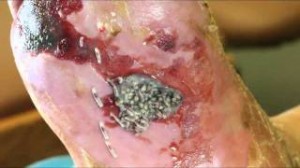Using Maggots In Place of Antibiotics To Lower Hospital Bills & Prevent Resistance
The first reported use of maggots (fly larvae) therapy was among the early civilization of the Mayans in Central America and the Aboriginals in Australia. Also, during the US Civil War, doctors noticed maggots were quite efficient in treating wounds on injured soldiers that had been neglected. However, this medical practise was later dropped in 20th century after the discovery of penicillin and other antibiotics.
But as time would prove it, the effectiveness of penicillin and other antibiotics became less effective since the bacteria mutated and acquired resistance to their effect. This made medical practitioners from all over the world think up of new ways to deal with preventing wounds from becoming infected, including adopting the long forgotten maggot treatment.
In 2004, the US Food and Drug Administration gave the green light for medical practitioners to use maggots for treating open wounds. The scientific explanation on why maggots are becoming the preferred choice for treating open wounds is as follows.
 Maggots feed on dead flesh (necrotic tissue) which is exactly the same thing that bacteria feed on when they invade an open wound. Meaning when maggots are placed on open wounds, they compete with bacteria for food and prevent bacteria from growing on the wound. Without bacteria present on the wound, the wound heals faster and the patient does not need antibiotic.
Maggots feed on dead flesh (necrotic tissue) which is exactly the same thing that bacteria feed on when they invade an open wound. Meaning when maggots are placed on open wounds, they compete with bacteria for food and prevent bacteria from growing on the wound. Without bacteria present on the wound, the wound heals faster and the patient does not need antibiotic.
The maggots excrete a certain enzyme on the wound that softens the dead tissue thereby making it easier for them to suck-in those tissues. By doing this, the maggots clean up the wound by getting rid of the dead tissue, making it difficult for bacteria to survive on the wound and in essence clean up the wound.
The maggots exclusively feed on dead tissue and do not attack the living tissue. This makes the patient heal without any pain, and the healing process is faster compared to when a patient is given antibiotics.
Doctors in Kenya are now adopting this medical practice of using maggots to treat open wounds. They are doing so for reasons mentioned above and also as a way of addressing the following challenges unique to the citizens of Kenya:
- Maggot treatment is not only faster but is also considerably cheaper. In a country where about 46% of the population live with a daily income of less than $1.25 per day. It’s a cost-effective method of treatment.
- Patients are required to pay an average of $10 per day to secure a bed in the state’s hospital. Meaning the longer one stays admitted in the hospital, the higher the hospital bill they will pay, considering 46% of the population live under $1.25 per day. It is better if a patient spends fewer days in the hospital.
- The cost of drugs including antibiotics is quite high, and majority of the patients have to pay for their medication. So a cheaper alternative and effective treatment will be a sigh of relief to many.
To read more on how doctors at the Kenyatta National Hospital in Nairobi are using maggots to give their patients with a cheaper, faster, safe and effective treatment. Follow this link, to the featured story on BBC.



